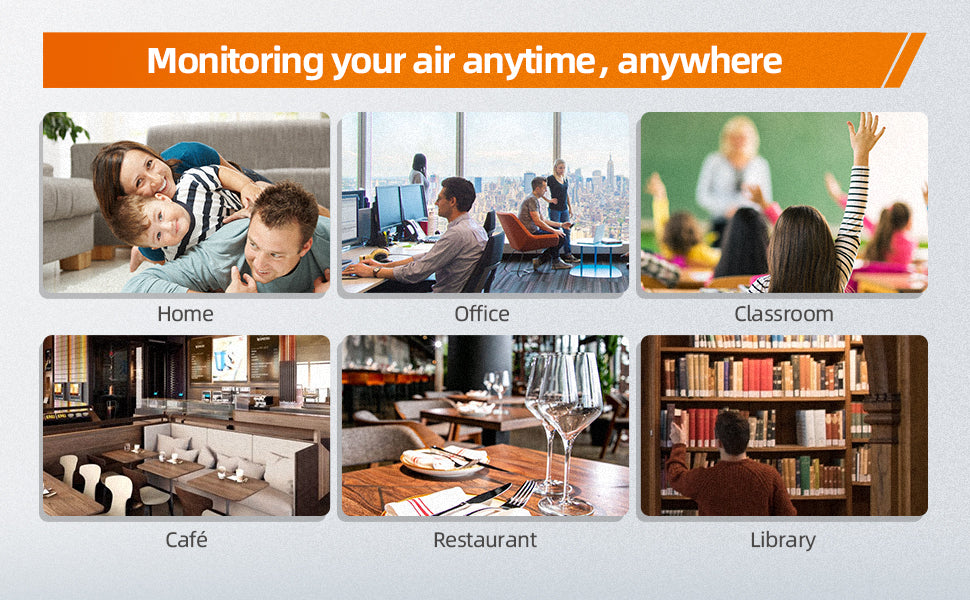
The Effects of CO2 Levels in Conference Room
You enter the meeting room with a keen mind and a clear purpose. Twenty minutes later, I was blind and distracted, and I found it difficult to keep up with the conversation. No matter how focused you are, you can't shake the fuzziness of passing through the room.
If you're used to this, you'll get good news and bad news. The good news may not be your fault. The bad news is that the carbon dioxide in the boardroom can affect your intelligence.
When people are distracted or tired in meetings, we can blame the lack of attention of the moderator, the material, or the audience. But what if the real culprit is our indoor air quality?
Most indoor air pollution is invisible, but it affects our physical and mental health in many ways. Here are some key reasons why you should be aware of carbon dioxide (CO2) levels at your next company meeting.
Know the air you breathe
One of the easiest ways to track changes in carbon dioxide levels is to use an air quality monitor. Tracking indoor pollution not only provides a real-time view of air quality, but also helps determine when to open Windows, update ventilation systems, and behavior that affects office health and productivity. I'll do that
Temtop's air quality monitor monitors levels of CO2, particulate matter (PM2.5), toxic chemicals (VOC), temperature, humidity, light and noise in space, making breathing easier and, at best, providing insights into function. Please contact us for more information about using the Temtop air quality monitor in the office.
Crowded Spaces lead to confusion
There are some scientific explanations for the state. When many people are crowded in a small space, they produce and exhale more carbon dioxide into the air. Most modern buildings are designed to be airtight. In other words, natural airflow is limited and proper ventilation is essential. Without functional Windows, fans and ventilation slots in the room, CO2 levels could rise to about 2.5 billion parts per million (PPM), about five times normal. In some schools, researchers found carbon dioxide levels above 5,000 parts per million.
Inhaling high levels of carbon dioxide can affect the brain's ability to metabolize oxygen. This reduces neural activity and ultimately makes clear thinking difficult. This decrease in brain activity can be fatal if it is prolonged and prolonged exposure. Although CO2 in conference rooms has not yet reached this extreme level of toxicity, research suggests that even modest increases in CO2 levels can have a significant impact on cognitive performance.
Make adequate decisions as co2 increases
To study the effect of indoor air quality on workplace performance, a team of researchers at Harvard University set up an environmentally controlled office to help workers in "green" and "traditional" building conditions. Test for cognitive function. They administered cognitive tests designed to assess employees' performance in nine categories:
- Basic activity level
- Application activity level
- Priority activity level
- Task oriented
- Crisis response
- Information search
- Use the information
- Close to the width of the
- Policy strategy
As the researchers gradually increased their CO2 levels, the subjects' test results declined in almost all categories. On days with low levels of carbon dioxide and volatile organic compounds (vocs) (simulating environmentally friendly building conditions), participants' cognitive test results were 61 per cent higher than in conventional building conditions.
When researchers accelerated the rate of outdoor ventilation in the office (classified as "green +"), the difference increased. The number of participants in the green + building condition was 101 per cent higher than in the traditional building condition, suggesting that proper ventilation of a building is crucial for employees to ensure its optimal functioning. Is put forward.
Carbon dioxide causes clinical symptoms
Thick building syndrome (SBS) describes a variety of health conditions associated with poor indoor air quality. Typically, the longer the symptoms stay in your contaminated building, the more severe the symptoms; Symptoms will improve when you move out of the building. It is well known that SBS not only reduces job satisfaction, but also reduces employee productivity and absenteeism. These are two factors that directly affect the bottom line.
Symptoms of SBS include headache, respiratory and skin irritation, fatigue, inattention, nausea, allergies, colds and flu. SBS is usually the result of various environmental factors (such as indoor CO2, PM2.5, VOC, temperature and humidity). But one study found that simply reducing CO2 levels could reduce the incidence of certain SBS symptoms, such as fatigue and headaches, by as much as 85%.
Save the next thought
The next time you feel nauseous or get bogged down in an endless conversation, consider the air quality of the room. Is the room warm and stuffy? It's been a while since I closed the conference room door. Are you less alert than you were a few minutes ago?
If in doubt, break the window, open the door, turn on the fan, take a walk and continue in a well-ventilated area. There is no guarantee that we will get rid of all the bad ideas, but it helps ensure that you are smart enough to understand the differences.
Product Link: https://www.elitecheu.com/collections/temtop-eu-air-quality-monitor

Leave a comment